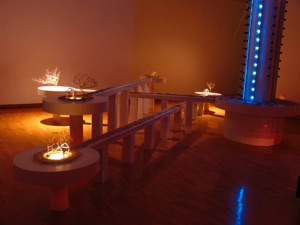David Sanchez Burr: Emergency - Multimedia video installation with sound, kinetics, video and automation
Donna Beam Gallery at the University of Nevada, Las Vegas 2009
David Sanchez Burr: Emergency - Multimedia video installation with sound, kinetics, video and automation
Donna Beam Gallery at the University of Nevada, Las Vegas 2009

Emergency
Transitions imply a progression of time; all materials (whether observable or not) are in transition from one state to another. As a species we are highly concerned with physical change. Vast amounts of energy, effort and wealth are devoted to preserving certain states of materiality. We like houses to look freshly painted, counters and shelves dusted and our metals polished. The pleasure of maintaining something as new can be viewed as preserving a certain state, to perpetuate it’s image of ourselves as a species that builds and creates objects precisely as we want them to appear. Our most noted landmarks and masterpieces are maintained meticulously by conservators in attempts to retain their particular look at the time of its creation. Artists throughout the ages have found materials and created techniques that address preservation, oil and pigments used now remain colorfast after centuries, hard sculpture materials can stretch a lifetime of millennia, and certain plastics today have an unknown period of durability. Yet alone and without intervention the best these techniques and materials can do is postpone the time in which decay, rust, decomposition, and disintegration take effect. As with art, all of our creations have a degree of concern with longevity, whether long or short. Some of the most common themes in the present era are related to performance over time. A measure of time can be viewed from various perspectives for example; the capitalist concept of planned obsolescence, the planned perpetuity of a vault in Scandinavia that contains and preserves millions of plant seeds, or the brief periods between new coats of paint on the Golden Gate Bridge. All examples of which are related to preserving states or controlling the measure of time in which decay or inoperability become present. In reference to monuments, cultures think in terms of centuries, we consider our individual or collective efforts as important to preserve and are proud in the construction of symbols that pertain to our culture, society, wealth and knowledge. Elaborate and simple works of art from all ages exist in suspended states of materiality in museums around the world, these works are useful in many ways and provide insight and historical knowledge but in terms of time as a subject they exhibit only a portion of the available reference.
Outside the culture of preservation exist countless sites that, without meticulous preservation efforts, illuminate a different sense of time. Site specific work such as Michael Heizer’s Double Negative or Smithson’s Spiral Jetty have a presence in which the active signs of natural decay provide the sensation that the site is in constant change regardless of our presence, these sites relate to us differently, whether intended or not, they relate to our species and its mortality, they are subject to the same conditions as we are. As their state is in evolution, the aesthetic experience is different from any preserved art, the pieces articulate different values and provoke a different thought process. A comparison can be made between work that is in temporary stasis due to our preservation efforts and artwork that has embedded in it an uncertain outcome. If we base this comparison on the process of creating the work, the striking difference shows that transformative work activates the artists sensitivities to embedded time based process. One can predict an outcome and maintain it or one can allow intangibles to permeate it. The outcome of both eventually are the same, and both paths are transitory elements of a period of time. One path will accept inevitability and the other is an effort to postpone it.

Projects
Past (web development in progress)
Beauty is on the Inside too.
2007
Metasonic Series 2008-2010
ansurbana 1991-2001